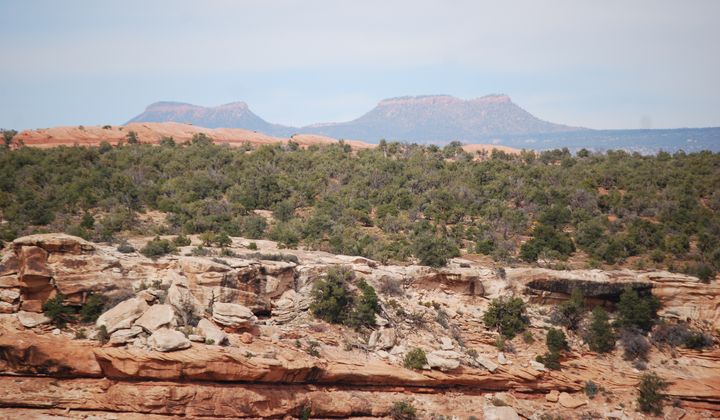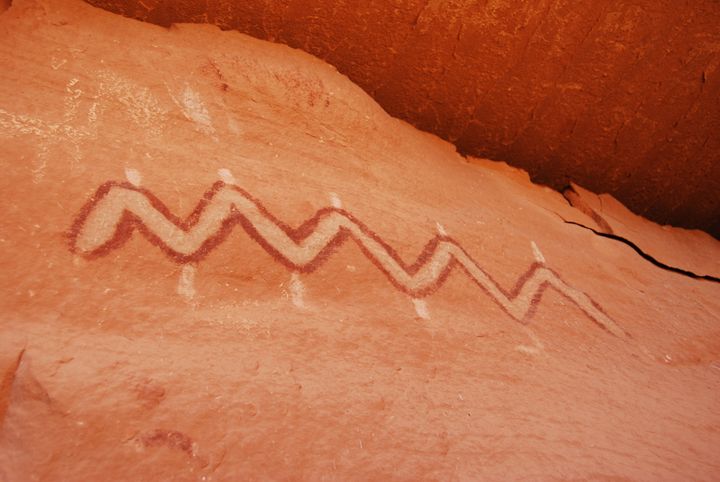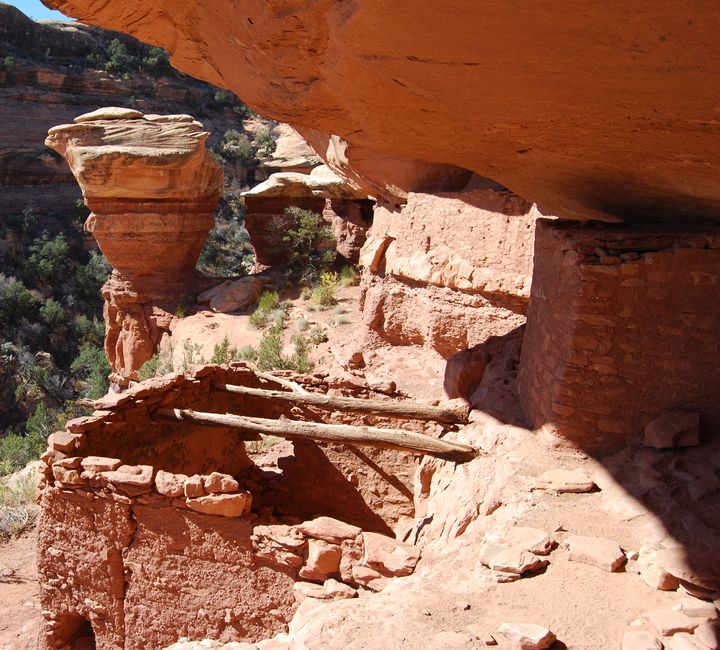This ancient Puebloan structure, now a historical landmark protected by Bears Ears National Monument, may have been inspired by a pair of eclipses

The Moon House dwelling is perched in a canyon on Cedar Mesa, in Bears Ears National Monument, at an elevation of 5,700 feet (1,740 meters) in a relatively arid region of southeastern Utah.
Imagine that you live in isolation on a beautiful mesa with a small band of subsistence farmers. Your territory is rugged and difficult to traverse, with steep slopes, deep canyons, and sandstone cliffs, and is strewn with boulders, hoodoos, balanced rocks, and other obstacles. Even the flat places are uneven and covered with piñon, cedar, shrub oak, yucca, cactus, and scrubby dessert plants.
The key to your survival is your ability to grow, store, and defend your food. You must cultivate it where you live, because transporting it over long distances would be impossible. You have no government or societal safety net. Your survival is up to you, and you are acutely aware that plants require sun, warmth, and water.
You have no written language, books, TV, computer, phone, internet, or recorded music. All you have is your intellect, your community, your family, and your civilization. You’ve identified items you can make without much technology, like rock art, baskets, stone tools, and clothing. When darkness falls, you have sky, fire, voices, faces, drums, flutes, food, sex, and dreams. That’s pretty much it.
Such was life for the ancestral Puebloan people, often called the Anasazi, who inhabited southeastern Utah. Their cliff-dwelling stage lasted between 1150 and 1300. During this span, they built and decorated a complex on a plateau called Cedar Mesa. In the 1960s, archeologist Bill Lipe of Washington State University dubbed it the “Moon House”. The name stuck.
The Moon House divides into three sections: a living area with about half a dozen households, a storage area, and a large room reserved for religious or social meetings. Throughout the structure, its walls carry decorations that may indicate that those who lived there carefully watched the sky.

How would you interpret this piece of rock art? Is it a snake? A flowing stream? Lighting during a storm? Your interpretation may be wrong and lead nowhere, or it could be the key to unlocking the secrets of the site.
Life as they knew it
The people who built the Moon House had a lot of time for observing. They certainly kept an eye on the weather, how clouds form, how storms move, how and when rain, virga, and snow falls. When the sky was cloud free, they observed how the Sun, Moon, stars, and planets tracked across it. Their understanding of natural cycles was handed down by their elders and reinforced by observations and personal experience. And because these cycles were the keys to their survival, they paid attention to the slightest detail and variation in the pattern.
Every once in a while something out of the ordinary would happen. A brilliant light streaks across the clear sky lighting up the entire mesa and causing hoodoos to cast moving shadows in the night. A fuzzy patch appears, grows a tail, and moves trough the constellations like a fast planet. A bright star that never existed before appears and then fades out. Many stars fall at once, like snowflakes. The Full Moon is swallowed up and glows a dim blood red. In their world, these were the dramatic, emotional, and terrifying external events that everyone would talk about, tell their grandchildren, and record.
Their lives and everything they knew and cared about depended on the seasonal cycle, which happened the same way every year. Where the Sun came up and where it set told them when to plant, because the sky was their calendar as well as their clock. After the harvest, the days got short and cold, and the nights got long.

Sunlight beams through small openings in the wall of the Moon House. Although they don’t correspond to the obvious lineups or markings, the sunbeams lend a touch of mystery to an already enigmatic site.
Endless Routine?
It took faith to believe that the Sun would come back and that it would ever be warm enough to grow food again. The Puebloans watched as the Sun set earlier and farther to south on the horizon at the fall of night -- each night longer and colder than the one before. Everyone expected and hoped the rate will slow, and eventually stop, because it always had.
And then one evening, the glowing orb stopped moving south. Across the mesas, that last beam of sunlight shone through a natural V in the rock, lighting up a spot on a nearby wall. Somebody pecked a spiral into the desert varnish as a reminder of where the beam would be on this day of celebration of the return of the Sun -- the winter solstice.
A half-year later, the opposite happened. Unlike winter, this was a joyful time of year with long, hot days and short nights. The crops would be growing fast, nourished by the Sun’s heat and light. Now the Puebloans watched as the Sun rose further to the north on the horizon every day, and another marker that told them when the longest day -- the summer solstice -- would arrive. On that day of celebration, they watched as the Sun rose nearly to the zenith (the overhead point) at midday. Its brilliant light bathed the canyons, and they welcomed it.
Surprise!
And then one day, something odd began to happen, something they had never witnessed before. In the middle of the day, the light started to fade and it got a little cooler. It was almost imperceptible at first, but then it became obvious. There was something wrong with the Sun...
Read the full article ”Is the Moon House an American Stonehenge?” in the July 2017 issue of Astronomy Magazine.

The outer wall of the Moon House stands beneath an overhanging cliff that has helped to protect the interior from wind and rain.
BEARS EARS: AMERICA’S NEWEST NATIONAL MONUMENT
One of President Obama’s final official acts while in office was to issue a Presidential Proclamation on Dec. 28, 2016, to establish Bears Ears National Monument. The proclamation reads, “Rising from the center of the southeastern Utah landscape and visible from every direction are twin buttes so distinctive that in each of the native languages of the region their name is the same…"Bears Ears." For hundreds of generations, native peoples lived in the surrounding deep sandstone canyons, desert mesas, and meadow mountaintops, which constitute one of the densest and most significant cultural landscapes in the United States. Abundant rock art, ancient cliff dwellings, ceremonial sites, and countless other artifacts provide an extraordinary archaeological and cultural record that is important to us all, but most notably the land is profoundly sacred to many Native American tribes… Resources such as the Doll House Ruin in Dark Canyon Wilderness Area and the Moon House Ruin on Cedar Mesa allow visitors to marvel at artistry and architecture that have withstood thousands of seasons in this harsh climate.”
With the stroke of his pen, President Obama preserved for all Americans this vast treasure of geological, ecological, archeological, historical, cultural, and astronomical heritage. It will never be mined or developed, and the same dark skies that were once enjoyed by 13th-century Ancestral Puebloan inhabitants will forever remain available for stargazing and tranquil contemplation by future visitors.
